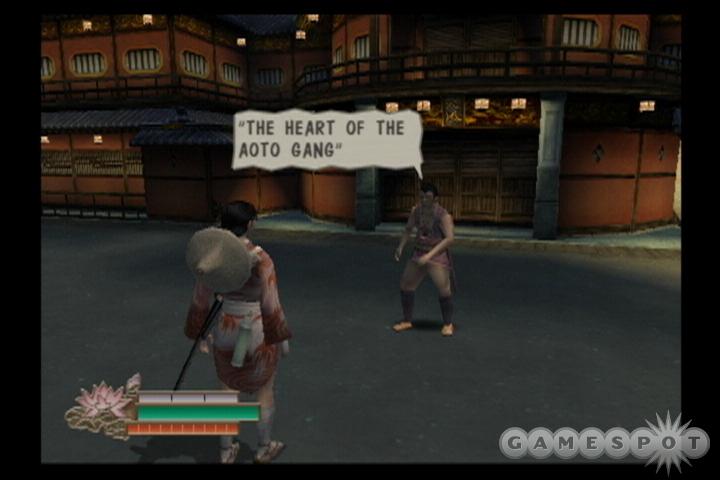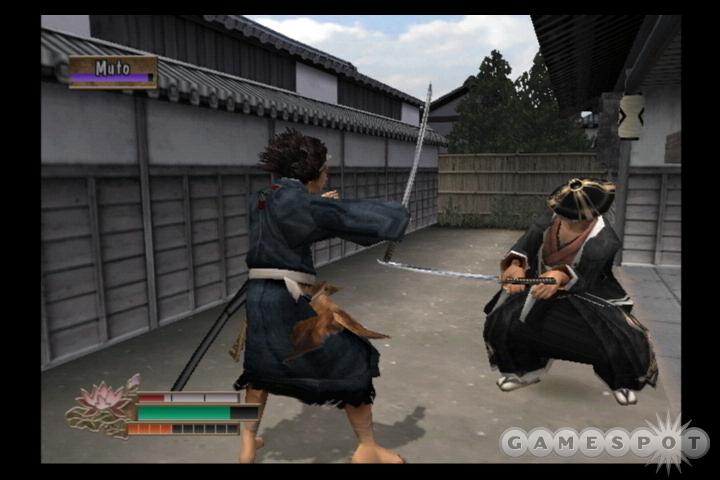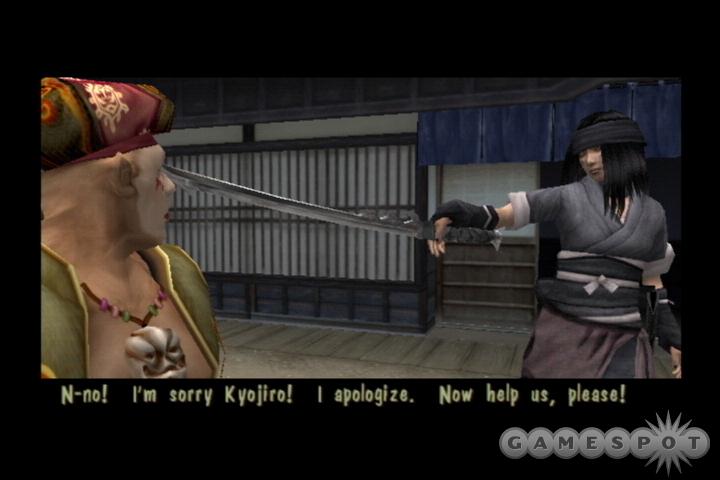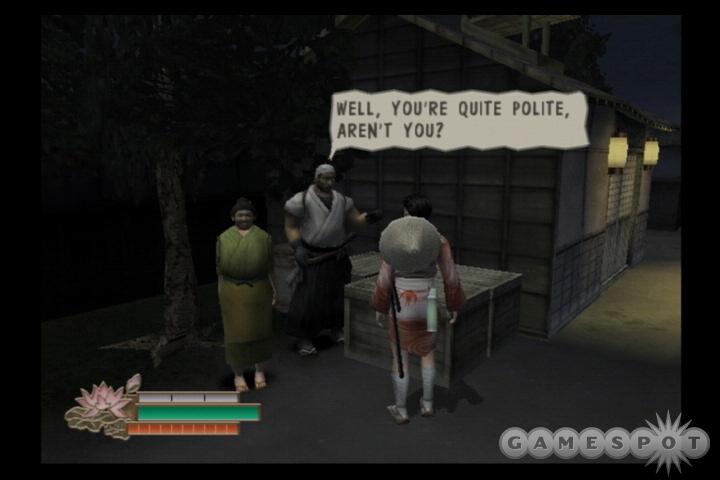Like its predecessor, Way of the Samurai 2 depicts a fascinating period of history in a unique fashion. In the game, you play as a masterless samurai looking to make ends meet in 19th-century Japan, at a time when the samurai caste was coming to an end, thanks to a social upheaval brought on by Japanese encounters with Western civilization and other factors. This third-person action adventure game lets you forge your own destiny in that chaotic time period as you take sides with a number of different factions, each looking after its own interests, in a small Japanese town. The game has an open-ended structure and more than 10 different endings, depending on the decisions that you make along the way. However, as interesting as Way of the Samurai 2 may sound, the concept of the game isn't well executed, resulting in an awkwardly paced experience that will only be appreciated by patient players willing to look past a variety of flaws.

No previous experience with the first Way of the Samurai game is expected from those who play the sequel, which essentially revisits the same material as the first game, but in a new setting and with a slightly different gameplay structure. The game takes place entirely in the small town of Amahara, which in gameplay terms consists of 10 very small areas that you're free to explore in any order. Though the story can branch off into various different directions, it always begins the same way, with your half-starved samurai character encountering a mute girl at the gates of Amahara. The girl gives you some food, but no sooner are you back on your feet than you run into a trio of strangely dressed ruffians. At points during the dialogue with these characters, you'll be prompted to respond with one of several different options--and your choices will set the story in motion. You then basically get to explore Amahara for about 10 days of game time. You may affiliate yourself with a powerful local gang; join the magistrates, which is the police force of Amahara; try to help out the little girl you met, and Amahara's other townspeople; and various other options. You may be surprised at how free-form the gameplay of Way of the Samurai 2 actually is.
Unfortunately, it's too free-form. The problem is partly that the game gives you too little direction about what to do or where to go at any given point and partly that Way of the Samurai 2's English translation is very uneven, which results in situations where you're forced to make very important decisions by choosing from dialogue options that make little sense. Gameplay ends up being less about choosing your own adventure and more about pure guesswork. Unless you go through the game with a walk-through that specifically tells you how to proceed at specific instances, you'll be left pointlessly wandering from one part of Amahara to another, wondering where the action is. This is a shame, because if Way of the Samurai 2 marked the map with places of interest, or provided you with a decent to-do list to keep track of your tasks, the game would have seemed a lot more coherent. As it stands, the game's open-ended structure is simply confusing. You never truly feel the passage of time or a sense of scale as you look for something to do in Amahara.

Don't take the lack of linearity in Way of the Samurai 2's gameplay to mean that there are a lot of different types of activities in the game, because there really aren't. Story-driven missions typically involve fighting someone, and the combat is the most fully developed aspect of the game. Other odd jobs may send you off to find abandoned babies or go looking for missing characters to try to convince them to return from whence they came, but these mission types are where the game's translation is at its absolute worst--you either won't know where to go or won't know what to say, and if you fail, then all you can do is sleep off the rest of the day (if you can remember which of the city's regions your home is in) and try again the next day. There's some other stuff to do in the game, like shopping for goods in various stores or getting your sword augmented by the local blacksmith. But these types of activities almost seem like distractions in hindsight. You can reach one of the game's different endings in only about an hour of play if you know what you're doing, or things can drag on for much longer than that if you don't.
It's true that part of the game's appeal lies in going through Amahara at your own pace and uncovering the different, possible outcomes. But even the game's replay value is limited, since the frequent story-driven cutscenes cannot be skipped, though at least you can fast-forward through the dialogue. For what it's worth, Way of the Samurai 2 does have multiple difficulty settings (which affect the strength of your opponents in combat), lots of different swords for you to collect and use, and different outfits and other trinkets to unlock, so there's a good amount of content to discover, which partly makes up for the game's short length.
You can fight pretty much anyone in Way of the Samurai 2, which is one of the better things about the game. Most townspeople will take it as a threat if you draw your blade in their vicinity, and if they're similarly equipped, they'll draw their own weapon and fight you. On other occasions, combat is unavoidable, and sure enough, the game's climactic conclusion--regardless of which of the many different endings you're heading toward--invariably involves some sort of showdown against a powerful opponent or opponents. Combat in Way of the Samurai 2 is superficially similar to that of a fighting game like Soul Calibur. You can execute vertical and horizontal slashes, string together a few such moves in some basic combos, float enemies into the air and keep hitting them while they're flailing about, and so on. The controls are responsive enough once you get used to them, but the game's rather jerky combat animation and occasionally frustrating camera angles detract from the fun of the swordfighting.

Also, the ability to execute parrying moves--performed simply enough by blocking a vertical attack while pressing up or down, or blocking a horizontal attack by pressing left or right--turns out to completely dominate the combat. Your block is impenetrable, so even if you're surrounded by foes, you're relatively safe just by holding down the R1 button; even if a foe executes an unblockable throwing maneuver against you, such moves are far weaker than slashes. You need only fear for your sword's durability, as represented by a meter that fills up as you attack or defend--your weapon will break if you don't let it "cool off" after so many hits. So you'll learn to just stand there in a defensive posture while deflecting any enemy attacks that come your way, since following a successful parry with a slash instantly kills normal foes and seriously injures boss-type characters. There's no good reason to experiment with all the other moves in the game when the counterattacking system is so effective, and it works as effectively regardless of which of the game's various weapons you're wielding. In this way, the combat in Way of the Samurai 2 becomes undermined much like the game's nonlinear framework.
Way of the Samurai 2 does have its moments. You can speak to any of the characters walking the streets, and they may respond to you differently depending on the choices you've made. Your notoriety will precede you if you shoplift or wantonly kill civilians, and if you choose to make enemies with Amahara's prominent factions, their members will attack you on sight. The game has a few other nice touches, like how you might inadvertently pick a fight with a thug literally just by bumping into him on the street, or how it's possible to play the factions against each other (rather than become their pawn), much like in the classic samurai movie Yojimbo, which is apparently the inspiration behind the Way of the Samurai games. Way of the Samurai 2 also deals with some mature themes. Not only is the combat bloody, but some of the storylines also involve sex and drug use--it's really nothing that you couldn't find in a PG-13 movie (except all the blood), but it's still fairly uncharted territory for video games.

Unfortunately, these types of things make Way of the Samurai 2 more of a curiosity than a worthwhile game, since there are too many other strikes against it. For instance, this sequel arguably looks worse than its 2-year-old predecessor, whose characters look at least as lifelike and whose frame rate is smoother than this new game--and the original Way of the Samurai didn't look that good to begin with. Decidedly unremarkable scenery and inconsistent quality in the character graphics (story-specific characters look good, while others don't) make Way of the Samurai 2 look fair at best. The same sort of thing can be said about the game's audio; some traditional-sounding Japanese music does a fine job of setting the tone for the experience when you're walking through the streets, but some of the other music, such as when you're fighting, isn't nearly as pleasant or befitting of the game. Also, the voice acting you'll hear during all of Way of the Samurai 2's story-driven cutscenes is of uniformly mediocre quality. Some of the performances are better than others, but in general, whatever situational drama might have been possible in this game is practically defeated by the ham-fisted acting.
The original Way of the Samurai wasn't a great game, but it was highly original and had lots of potential. Unfortunately, this sequel doesn't make good on that potential and is liable to disappoint fans of the first game reasonably expecting the sequel to be an improvement on its predecessor. At any rate, Way of the Samurai 2 does retain many of the same interesting features as the previous game, but you'll need to cut through a lot of chaff to get to them.